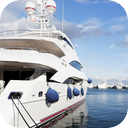(short preview of full seamless looping track)
Yacht
This product is not available in the selected currency.
In Stock
Backordered
Out of Stock
Description
The white spray spits salty sea air onto the deck as your long hair hails the shore behind you with frivolous waves that shine in the rays of the sun. The white bow shines in the sea of blue below and against the blue above like a fast moving cloud stuck to the surface of the earth trying desperately to find the edge by charging the horizon with all its might. Day sailing yachts are usually small, at under 6 metres (20 ft) in length. Sometimes called dinghies, they often have a retractable keel, centreboard, or daggerboard. Most day sailing yachts do not have a cabin, as they are designed for hourly or daily use and not for overnight journeys. At best they may have a 'cubby', where the front part of the hull has a raised solid roof to provide a place to store equipment or to offer basic shelter from wind or spray. Weekender yachts are slightly larger, at under 9.5 metres (31 ft) in length. They often have twin keels or lifting keels such as in trailer sailers. This allows them to operate in shallow waters, and if needed "dry out"—become beached as the tide falls. The hull shape (or twin-keel layout) allows the boat to sit upright when there is no water. Such boats are designed to undertake short journeys, rarely lasting more than 2 or 3 days (hence their name). Cruising yachts are by the far the most common yacht in private use, making up most of the 7 metres (23 ft)-14 metres (46 ft) range. These vessels can be quite complex in design, as they need a balance between docile handling qualities, interior space, good light-wind performance and on-board comfort. The huge range of such craft, from dozens of builders worldwide, makes it hard to give a single illustrative description.
http://www.soundsnap.com/node/96085
Opps
Sorry, it looks like some products are not available in selected quantity.



